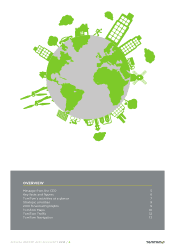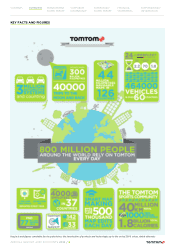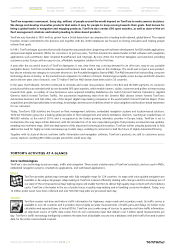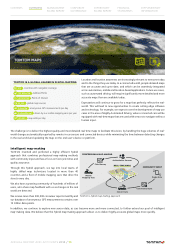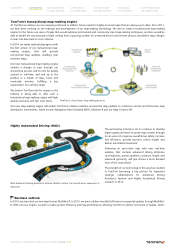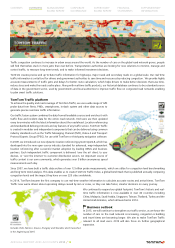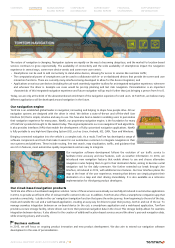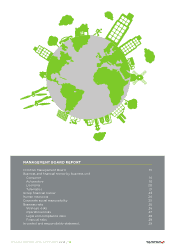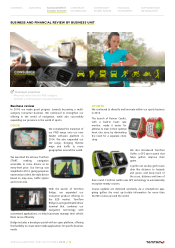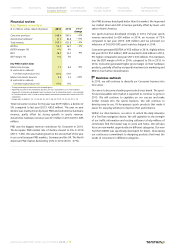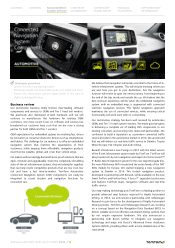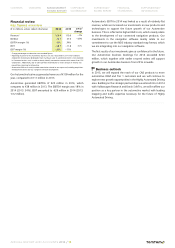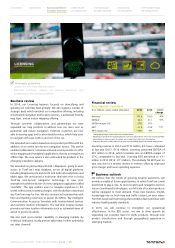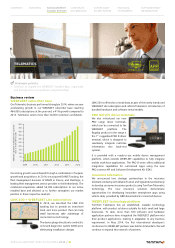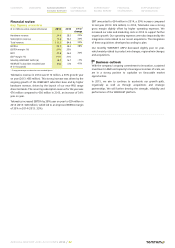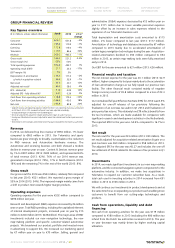TomTom 2014 Annual Report Download - page 13
Download and view the complete annual report
Please find page 13 of the 2014 TomTom annual report below. You can navigate through the pages in the report by either clicking on the pages listed below, or by using the keyword search tool below to find specific information within the annual report.
The nature of navigation is changing. Navigation systems are rapidly on the way to becoming ubiquitous, and the market for location-based
services continues to grow exponentially. The availability of connectivity and the wide availability of smartphones impact the navigation
experience in several ways, some more device-centric and some more user-centric:
• Smartphones can be used to add connectivity to stand-alone devices, allowing for access to services like real-time traffic;
• The computational power of smartphones can be used to collaborate with in- or on-dashboard devices that provide the screen and user
interaction functions. There are currently many interfaces being developed to allow for this device integration; and
• Applications on various user devices (including the car) work seamlessly together to allow for an integrated navigation experience, whenever
and wherever the driver is. Example use cases would be pre-trip planning and last mile navigation. Personalisation is an important
characteristic of this integrated navigation experience and future navigation will go much further than just bringing a person from A to B.
Today, we are only at the brink of the abovementioned enrichment of the navigation experience for end users. At TomTom, we believe many
different applications will be developed around navigation in the future.
Our navigation engine
TomTom is an established global leader in navigation; innovating and helping to shape how people drive. All our
navigation systems are designed with the driver in mind. We deliver a state-of-the-art and off-the-shelf User
Interface (UI) that is simple, intuitive and easy-to-use. We have also been a leader in enabling users to personalise
their navigation experience for many years. NavKit, our proprietary navigation engine, is the foundation for many
of TomTom's products brought to the market today. This engine implements our core navigation IP and algorithms.
It also provides interfaces (APIs) that enable the development of fully customised navigation applications. NavKit
is fully portable to any high-level Operating System (OS), such as Linux, Android, iOS, QNX, Tizen and Windows.
Bringing connected navigation into the vehicle is a complex task. As a result, TomTom has developed a range of
software components and tools that make it easier for our automotive customers to integrate navigation in their
own systems and platforms. These include routing, free text search, map visualisation, traffic, and guidance that
are rich in features, meet automotive quality requirements and are easy to integrate.
Our navigation software development follows the evolution of our traffic service to
facilitate more accuracy and new features, such as weather information. In 2014, we
introduced new navigation features that enable drivers to see and choose alternative
navigation routes helping them to get to their destination faster, aiming to become a vital
navigation tool for the daily commuter. We further extended our break through User
Interface, introduced in 2013, with additional core features. Our User Interface places the
map at the heart of the user experience, meaning that drivers can simply pinpoint their
destination on a map and start driving immediately. It is also available as a reference
implementation for third-party product developers.
Our cloud-based navigation products
TomTom also offers a cloud-based navigation solution. Some of these services were already successfully introduced in automotive applications
in 2014, to provide an efficient offer of relevant traffic content in the car. In addition, TomTom also offers a smartphone companion app that
provides connectivity, 'outside-in-the-car' navigation (navigation function that spans the entire journey, from beginning to the end of the trip,
inside and outside the car) and a web-based application, creating an easy way for drivers to plan their journey, both in and out of the car. To
manage seamless integration between an on-board device (in the car), a smartphone application and a web-based application, TomTom
provides a secure storage facility, where drivers can store their personal navigation data in the cloud. This storage facility allows for seamless
integration between devices. It also allows for the creation of additional location-based services around the driver's personal navigation data,
while ensuring privacy and security.
Business outlook
In 2015, we will focus on ongoing product innovation and new product development. We also aim to extend our navigation software
development in the area of personalisation.
CONTENTS OVERVIEW MANAGEMENT
BOARD REPORT CORPORATE
GOVERNANCE SUPERVISORY
BOARD REPORT FINANCIAL
STATEMENTS SUPPLEMENTARY
INFORMATION
ANNUAL REPORT AND ACCOUNTS 2014 / 13



